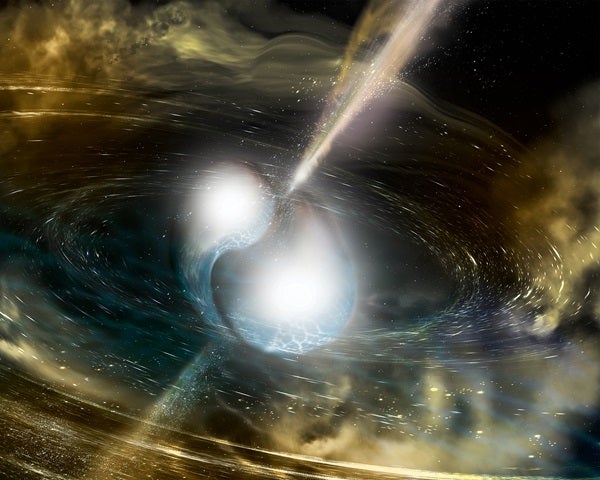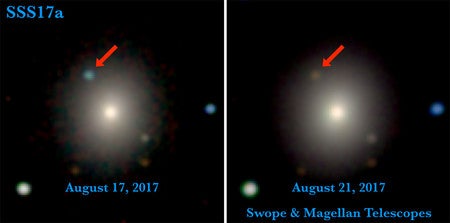The sequence of events started at 8:41 a.m. Eastern time when a train of gravitational waves started rolling through the Virgo detector near Pisa, Italy. The same waves rumbled through the LIGO detector in Livingston, Louisiana, just 22 milliseconds later, then the twin LIGO detector in Hanford, Washington, 3 milliseconds after that.
The LIGO and Virgo instruments detected a crescendo of waves for a whopping 100 seconds — much longer than previous detections. The duration, amplitude, and frequency of the waves had all the characteristics that theorists have expected for a binary system consisting of two neutron stars on a death spiral ending with coalescence. Neutron stars are ultradense objects that form from the core collapse of massive stars when they go supernova. These two neutron stars had masses of about 1.5 and 1.1 solar masses, respectively. About 1 to 2 percent of that mass was likely ejected into space during the merger, which presumably resulted in a black hole of nearly 3 solar masses, although the LIGO data does not prove that a black hole formed. If a black hole indeed formed, it’s the lightest black hole yet known.
“This discovery is amazing,” says LIGO team member Chad Hanna of Penn State University. “We have all been hoping for a neutron star merger for a long time, and we knew it would come eventually. But it was pretty remarkable to have it come so early.”
Seeing the light
The joint LIGO/Virgo detection by itself was a momentous discovery: the first direct detection of gravitational waves from merging neutron stars. It follows closely on the heels of the October 3 announcement that LIGO founding fathers Rainer Weiss, Kip Thorne, and Barry Barish earned the 2017 Nobel Prize in Physics for their pivotal roles in detecting the first gravitational waves — ripples in the fabric of space-time first predicted in 1915 by Albert Einstein in his general theory of relativity.
But what really sets this new detection apart is the fact that the gravitational waves were accompanied by a bright source of light. All four prior LIGO discoveries resulted from the inspiral and merger of binary black holes, which produced no detectable light that could reveal further information about the events. This was expected: black holes are essentially regions where space-time has collapsed around itself, so their mergers don’t involve any matter that can emit light.
In contrast, neutron stars are city-sized objects consisting of highly compressed matter, so their mergers are messy, violent affairs. And that’s exactly what was seen. Just 1.7 seconds after the August 17 merger, NASA’s Fermi Gamma-ray Space Telescope and the European INTEGRAL satellite picked up a gamma-ray burst (GRB) lasting nearly 2 seconds from the same general direction of sky. Both the Fermi and LIGO teams quickly alerted astronomers around the world to search for an afterglow.
Various ground- and space-based telescopes swung into action. Within 10-11 hours after the merger, the Chile-based 4-meter Blanco Telescope, with its wide-field Dark Energy Camera, and the 1-meter Swope Telescope had both independently pinpointed the optical afterglow in the elliptical galaxy NGC 4993, in the southern constellation Hydra. At a distance of 130 million light-years, this was one of the closest GRBs ever observed. The Hubble Space Telescope, the Chandra X-ray Observatory, the Very Large Telescope, the Very Large Array, and numerous other telescopes have studied the afterglow across the electromagnetic spectrum as part of a major international observing campaign. In all, the afterglow has been observed by 70 telescopes.
“All of these observations give us a much more complete picture of the neutron star merger and its aftermath than we would have had with gravitational waves alone, or with light alone,” says LIGO team member Amber Stuver of Villanova University, emphasizing the importance of multi-messenger astronomy.
Short GRBs are among the universe’s most powerful explosions, unleashing almost as much energy in a few seconds as the Sun will radiate in its entire 10-billion-year lifetime. But they are significantly less energetic than their long-duration cousins, which are thought to originate from exploding massive stars.
The fact that satellites observed the GRB almost simultaneously with the neutron star merger strongly supports Einstein’s prediction that gravitational waves travel at the speed of light. Theory predicts that the jet produces its gamma rays a few seconds after the neutron stars merge, so the 1.7-second delay between the merger and the GRB matches the predicted sequence of events if both the gravitational waves and gamma rays were traveling at light speed. According to Julie McEnery, the Fermi Project Scientist at NASA’s Goddard Space Flight Center, “The gamma rays and gravitational waves traveled 130 million years across space and arrived at Earth within 2 seconds [of each other]. Einstein passes another test.”
“That delay is about what we expected for the general gamma-ray burst model,” says Penn State astrophysicist Peter Mészáros, one of the originators of GRB theory. “The jet takes a certain time to expand before it’s able to produce the shocks that produce the gamma-rays. The time delay is in the ballpark of what we had estimated. That was a nice confirmation of the basic GRB model.”
The consistency between the LIGO, GRB, and traditional astronomical observations, in conjunction with theoretical predictions, removes any lingering doubts that LIGO has indeed been detecting gravitational waves for the past two years. As Stuver says, “We have all this redundant data coming in that is telling us that this is not an accident.”
A resounding success
LIGO’s five announced gravitational-wave detections all beautifully match predictions based on general relativity. In the four merging black hole binaries, the black holes contained 8 to 36 solar masses, and the final inspirals and mergers produced gravitational waves in LIGO’s frequency band for just 1/4 to 1.5 seconds. Because neutron stars have much lower masses than black holes, the final inspiral and merger in the August 17 event unfolded over a much longer timescale, producing waves in LIGO’s frequency range for about 100 seconds.
In those 100 seconds, astronomers saw about 1,500 orbits of the binary neutron star pair; astronomers think the system was about 11 billion years old. The neutron stars were just 200 miles (320 kilometers) apart when astronomers first heard them, says astrophysicist Vicky Kalogera of Northwestern University.
Although the sequence of events played out in a manner very close to theoretical predictions, the gravitational-wave signal was a bit weaker than expected for neutron stars colliding at a distance of 130 million light-years. The short GRB itself was also relatively low in energy for its class. The combined observations suggest we saw the neutron stars orbiting each other at an angle, and that we saw the GRB jet at an angle rather than looking down the barrel. These offset viewing angles reduced the observed intensity of the gravitational waves and the gamma rays.
Further evidence for an off-axis viewing angle comes from the fact that it took 9 days for the kilonova to show in X-rays, when Chandra saw it. This indicates that the jet was not pointing directly toward Earth. This is the first time astronomers have observed an off-axis jet in X-rays, while the X-ray emission itself also supports the notion that a black hole formed in the merger. There were no radio detections until the Very Large Array saw the afterglow 16 days after the merger. This delay also indicates that we were seeing the jet off-axis. The radio source is still bright and will be the last to fade away.
Animation of Neutron Star Merger and Aftermath from NRAO Outreach on Vimeo.
These mergers and their aftereffects are called “kilonovae.” Astronomers will continue to monitor the afterglow until it fades away, which will reveal how the ejected material interacts with its surrounding environment. This will help astronomers learn about the vital role that kilonovae play in cosmic chemistry by producing heavy elements, such as gold and platinum. According to Marica Branchesi of the University of Urbino, Italy, a “large amount of these heavy elements form in this kind of merger.” It is also the decay of radioactive elements produced in the collision between the jets and the surrounding material that powers the afterglow.
Kilonovae can explain the cosmic abundance of gold and platinum without any need for supernovae to produce these very heavy elements. Those elements will eventually combine with other material to form stars and planets. Edo Berger of the Harvard-Smithsonian Center for Astrophysics explained that astronomers saw “direct fingerprints” of these heavy elements in the data from the Chilean telescopes. He added that the total mass of heavy elements created by the kilonova was 16,000 times the mass of Earth, including 10 times the mass of Earth in gold and platinum alone. And in reference to that gold, Andy Howell of the Las Cumbres Observatory and the University of California-Santa Barbara said, “We really did see a pot of gold at the end of a kilonova rainbow.”
The ability to detect gravitational waves from neutron star mergers was the result of decades of brilliant theoretical research combined with the painstaking work of dedicated teams of thousands of scientists and engineers. Still, this detection owed a little bit to Lady Luck. The twin LIGO detectors caught the merger just 8 days before they were shut down for several months of scheduled upgrades. And Virgo was turned on just 16 days prior to the merger. Having all three detectors online was crucial to triangulating the gravitational source to a small enough area of sky (about 28 square degrees) that conventional telescopes could spot the afterglow.
In addition, Mother Nature delivered a neutron star merger well within LIGO’s and Virgo’s detection range. Previously, LIGO team members thought they might have to double LIGO’s sensitivity before they could see deep enough into space to catch gravitational waves from merging neutron stars.
“There’s always luck involved with detecting any gravitational wave, because we have no way of predicting when any of them are going to come by us,” says Stuver. “So yes, this was a gift. Honestly, this is something better than I could have ever hoped for. And I didn’t expect the observation of the first neutron star merger to come along with observations of light. We are really starting the multi-messenger astronomy era.”
To the future
The event’s optical afterglow initially shone at 17th magnitude – bright enough to allow amateur astronomers with large telescopes to detect it. Although the bright blue afterglow faded and reddened quickly, this still opens the door for amateurs to play a part in future gravitational-wave events.
For his part, Hanna wonders if astronomers have been underestimating the rate of neutron star mergers. If so, we can expect many more LIGO detections in the coming years that are accompanied by GRBs. Moreover, some short GRBs might result from mergers between a black hole and a neutron star, and LIGO and Virgo could play critical roles in determining if the GRBs from these events differ from those of neutron star mergers. “I’m hoping that rather than being lucky, we’re seeing a representative sample, an indication of what is to come,” says Hanna.
David Shoemaker of MIT says that LIGO will take a year off for upgrades, increasing the detectors’ sensitivity by a factor of 2 – boosting the volume of space they can search by a factor of 8.
So for now, Hanna and his colleagues on the LIGO and Virgo teams will marvel at their latest discovery. “How would you ever imagine that we’re measuring the dynamics of these tiny little compact objects smashing together 130 million light-years away?” he asks. “The fact that LIGO is doing this now, and with high confidence, is pretty incredible.”
If you’d like to learn more about the history of gravitational-wave astronomy, check out Astronomy magazine’s free gravitational wave eBook.











